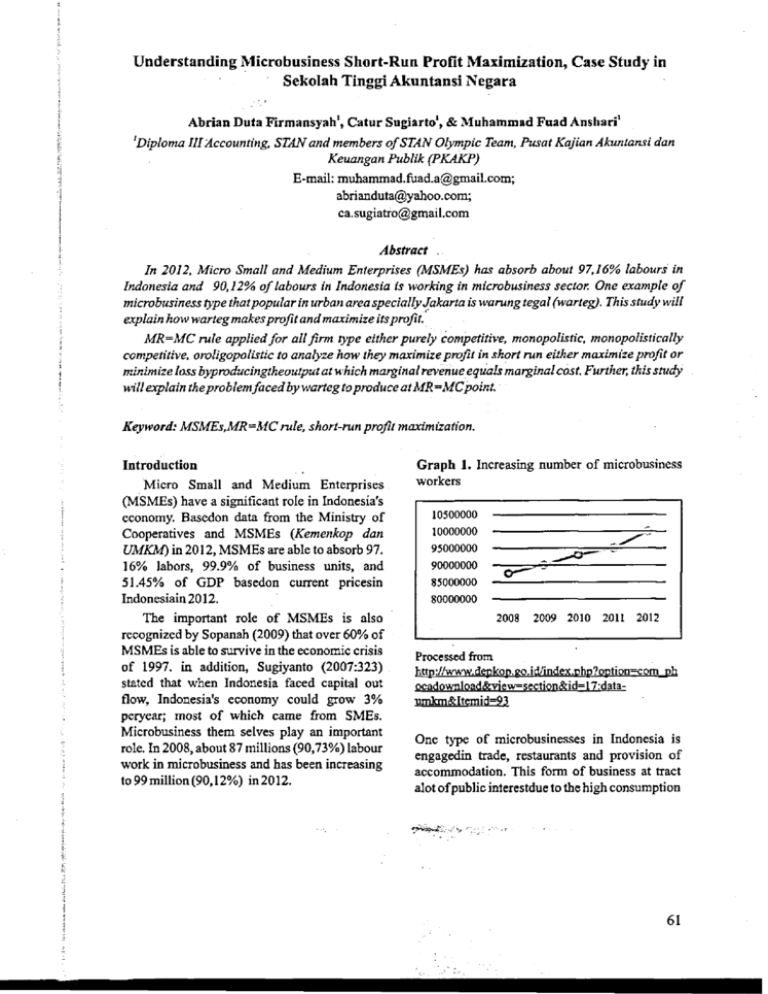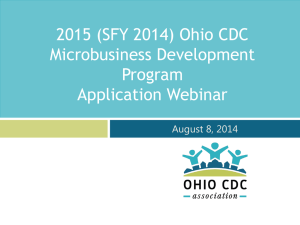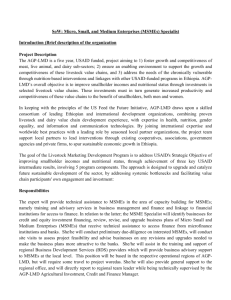Understanding Microbusiness Short-Run Profit Maximization, Case
advertisement

Understanding Microbusiness Short-Run Profit Maximization, Case Study in
Sekolah Tinggi Akuntansi Negara
Abrian Duta Firmansyah', Catur Sugiarto1, & Muhammad Fuad Anshari 1
'Diploma III Accounting, STAN and members of STAN Olympic Team, Pusat Kajian Akuntansi dan
Keuangan Publik (PKAKP)
E-mail: muhammad.ruad.a@gmail.com;
abrianduta@y ahoo. com;
ca.sugiatro@gmail.com
Abstract
In 2012, Micro Small and Medium Enterprises (MSMEs) has absorb about 97,16% labours in
Indonesia and 90,12% of labours in Indonesia is working in microbusiness sector. One example of
microbusiness type thatpopular in urban area specially Jakarta is waning tegal (warteg). This study will
explain how warteg makesprofit and maximize its profit.
MR=MC rule applied for all firm type either purely competitive, monopolistic, monopolistically
competitive, oroligopolistic to analyze how they maximize profit in short run either maximize profit or
minimize loss byproducingtheoutput at which marginal revenue equals marginal cost. Further, this study
will explain theproblemfaced by warteg to produce at MR =MCpoint.
Keyword: MSMEs,MR=MC rule, short-run profit maximization.
Introduction
Micro Small and Medium Enterprises
(MSMEs) have a significant role in Indonesia's
economy. Basedon data from the Ministry of
Cooperatives and MSMEs {Kemenkop dan
UMKM) in 2012, MSMEs are able to absorb 97.
16% labors, 99.9% of business units, and
51.45% of GDP basedon current pricesin
Indonesiain2012.
The important role of MSMEs is also
recognized by Sopanah (2009) that over 60% of
MSMEs is able to survive in the economic crisis
of 1997. in addition, Sugiyanto (2007:323)
stated that when Indonesia faced capital out
flow, Indonesia's economy could grow 3%
peryear; most of which came from SMEs.
Microbusiness them selves play an important
role. In 2008, about 87 millions (90,73%) labour
work in microbusiness and has been increasing
to99million(90,12%) in2012.
Graph 1. Increasing number of microbusiness
workers
10500000
10000000
95000000
90000000
85000000
80000000
2008 2009 2010 2011 2012
Processed from
http://www.depkop.go.id/index.php?option=com_ph
ocadownload&vie w=section& id=17 :dataumkm&Itemid=93
One type of microbusinesses in Indonesia is
engagedin trade, restaurants and provision of
accommodation. This form of business at tract
alot ofpublic interestdue to the high consumption
61
level, especially indensely populated are a such
as urbanaras or around campus, evidenced by
BPS statistics 1996-2004, which states that large
and retailtrade, restaurants, and accommodation are
morethan 50% of the total businesses field in
Indonesia. An example of restaurants in
microbusiness is Warung Tegal (Warteg).
Table 1. Percentage of large and retail trading,
restaurants, and accommodation in nonregulated business by by business field in 19962004
1996
1998
1999
2000
2001
2002
2003
2004
58,24%
61,16%
- : - 59,69% .v
61,15%
• V--. 57,64% ; •
58,79%
58,47% "
61,16%
;
Processed from:
http://www.bps.go.id/tab_sub/view.php?tabel=l&da
ftar=l&id_subvek=35
Warteg businesses have a fundamental
philosophy; it sells rice which is the staple food.
According to Abraham Maslow, food, clothing
and shelter are classified as basic physiological
needs, needs that must bemet. This is a business
opportunity for warteg especially in urban areas.
In addition, Rahayu (2008) stated that 77.9% of
Tegal's people go to Jakarta and surrounding
areas to open warteg.
Why this micro scale business is being
popular among tegal's people. This business must
be profitable and this is the objective of this
research that to understand how microbusiness
like warteg makes profit and maximizes profit.
Theoretical Background
1. Microbusiness
Microbusiness has a various definition in
Indonesia as listed below:
62
a. Law 20 of2008 about MSMEs article 1 and 6
defined that microbusiness is a productive
business owned by personal or personal
businesses entity whose net asset no more
than 50 million rupiah and revenue less than
300 million rupiah per year.
b. The Indonesia Centeral Statistic Bureau
defined that microbusiness characteristic is
have less than 5 workers including unpsin
family worker.
From definition above, researchers conclude
that warteg counted as microbusiness because
warteg often have no more than 5 workers and
owened by a personal or family based industry.
2. Short-Run Profit Maximization
Business continuity influenced by it sprofitas
stated by Pindyck (2009, 281) that in short run,
firms will continue the production i f the product's
price is greater than average variable cost. In micro
economically sis, the entity faces problems of
how to maximize profits. Arnold (2008:202) said
that business profit is maximized by producing
quantity of output at which MC=MR in addition,
McConnel (2009,182) stated that in theshortrun,
the firm will maximize profit or minimize loss by
producing the output at which marginal revenue
equals marginal cost (as long as producing is
preferable to shuttingdown). This MR=MC rule
is an accurate guide to profit maximization for all
firms whether they are purely competitive,
monopolistic, monopolistically competitive, or
oligopolistic. This rule illustrated in graph 2.
Graph 2. Short run profit maximization for a
purely competitive firm
J2Wi
0
1
1
2
3
4
S 6
Output
7
B
9
I
0
Source: McConnel (2009,184), Economics:
principles, problems, and policies eighteenth editions
Research Method
1. Type and source data
Data used in this paper is primary and
secondary data. Primary data collected by face to
face interview with warteg owners. Researchers
begin the interview with structured interview to
eliminate fluctuation in the data that result from
differences in when and how question asked then
unstructured interview to gain more complete
information, Bordens (2011,272). Secondary
data collected from external source, this type of
data called external data. External data is data
created, recorded, or generated by an entity other
than the researcher's organization like libraries,
the internet, and vendors, Zikmund (172,2010).
Researchers used libraries and internet only.
2. Sampling method
Researchers used purposive or judgmental
sampling for study in this paper. Because
researchers worked with a very small samples to
meet the research objective, Saunders
(2009,237).
3. Analytical method
Researcher use descriptive qualitative to
analyze the data. First, researchers use MR=MC
models to explore if warteg is in their maximum
profit position or not using an assumption that
every warteg face perfectly competition market
in very short-run basis (one day) then giving
recommendation to either maximize profit or
minimize losses. Second, researcher will
describe factors that might affect warteg's profit
based on descriptive data and related research
publications.
Output and Data Analysis
1. Sample and data description
Sample is warteg a selected area which is near
to STAN campus. The area included Kalimongso
(7 respondens), PJMI (1 Responden), Ceger (3
respondens), and Sarmili (2 respondens) with
total 13 respondends.
Basedoninterview, researcherscollect
including data:
a. Averageplates sold per day;
b. Average priceperplate;
c. Fix cost (electricity, water, rent of land
and Building) per day;
d. Variable cost (raw material, cost related
to cooking process, and produce food)
per day; and
e. implicit costs (minimum wage in South
Tangerang for 2013 and or similar rental
cost in the area) per day.
Unfortunately, because lack of adequate
spending record, this paper can't distinguish the
mixed cost. It caused a restriction in MR=MC
rule analysis specially to drawthe exact warteg
position in the curveand quantity for maximum
profit.
2. MR=MC rule analysis
Assuming every warteg face nearly perfectly
competition market invery shot-run (one day),
which they cannot change price easily with many
competitior in the area. It implies price = MR. To
calculate MC, researcher use n-1 data with
assumption only raw material added and neither
addition of fix cost nor mixed cost needed so MC
= AVC (Average Variable Cost) per plate.
MR=MC rule analysis can be seen at table 2.
Table 2. MR=MC rule analysis in 13
respondens
No
1
2
3
4
5
6
7
8
9
10
11
12
13
Q
300
200
100
100
166
117
75
100
77
100
180
65
30
P
6,000
6,500
8,000
8,000
6,000
6,000
10,000
8,000
5,000
7,000
6,500
12,308
5.000
AVC
3355
4036
3340
3600
3313
2571
5967
5500
2597
5000
5556
6231
13333
Profit
607,883.56
447,834.31
435,748.86
421,700.00
421,582.19
388,984.02
261,404.11
208,904.11
181,010.27
166,602.74
150,000.00
128,333.33
(271,141.55)
Analysis
MR>MC
MR>MC
MR>MC
MR>MC
MR>MC
MR>MC
MR>MC
MR>MC
MR>MC
MR>MC
MR>MC
MR>MC
MR<MC
Location
KL
KL
KL
KL
KL
PJMI
Ceger
Ceger
Sarmili
Ceger
Sarmili
KL
KL
KL=Kalimongso
63
From table 2 we can conclude that:
a. 12 warteg is profitable because their
MR>MC so they supposed to maximize their
profit;
b. Only one warteg is loss because it has
MR<MC and must minimize this losses;
There is a few trend in kalimongso area that
increasing quantity tend to increase profit;
There is no trend to identified any relation
between lower prices and profit; and
c. In the Top 5 Profitable warteg are dominated
by Kalimongso area, but the most
unprofitable warteg also in kalimongso area.
3. Maximizing profit in short-run
Warteg in which their MR>MC should
increase their profit by increasing the
production/selling quantity (this theory seems
occur in kalimongso areas that increasing
quantity tend to increase profit). To increase the
production and selling level, warteg must
increase MC. For example adding more space to
costumers and hiring more employee that meant
warteg owner must spend more in capital
expenditure. Setyari (2005) stated that the lack of
capital and low access to finance is attached to the
MSMEs. Capital problem can be solved by
adding factors of production through financing.
Unfortunately, microbusinesses generally face
problems in financing. It is as stated by Alhusain
(2010:179) that microbusinesses are expected to
provide employment, but to expand their
businesses many of them are hampered by
funding problems because of the poor access to
creditor loans from the bank.
Many responden explain that they did not do
the financing because of three reasons:fear of in
ability to pay the principal and the interest of loan,
unawareness of the existence of soft loans such as
Kredit Usaha Rakyat (KUR), and unawareness
about the benefits of borrowing from financial
institutions or non-governmental official.
Besides of psychological factors such as fear,
there is also asymmetry of information. Pindyck
(2009:617) says that a symmetric information
exists when some parties know more than the
others. Salvatore (2006:263) states that a
symmetric information occurs when one party
has more information than others about product
64
quality.
One example of a symmetric information is
when the owner of warteg X (micro-businesses)
apply for loans without collateral to financial
agency. The agency requires financial data which
show that the warteg X has a good level of
liquidity. However, warteg does not performad
equate accounting records. The agency concludes
that it is too risky to give aloan. This example is
inaccordance with the statement of Idris(2010)
that the scale of highest KUR priorities is
influenced by perceptions of the bank regarding
the credit risk of the borrower. Examples of other
a symmetric information is the number of microbusinesses that are not aware of the KUR
program as experienced by either the owner of
Warteg or KUR agencies can not mapping the
regional microbusiness potential. As expressed
by Organization for Economic Co-operation and
Development that the a symmetric information
occurs when financial service agencies do not
give credit to potential borrowers.
Only one warteg is loss the main reason for
this loss is the 13* warteg sells cheapest price
(MR), has the highest MC, and sells only a few
product. This implies MR<MC, 13lh warteg
should either reducing MC or increasing MR. to
reduce MC, 13Ih warteg shouldsell more product.
Selling more product can minimize cost
indirectly (minimize MC) because in very short
run analysis MC=AVC=VC/Q. Besides,
Increasing price (MR) might not affect the profit
because the 9* warteg sells a same price and
makes profit.
Other factor might affect the 13lh warteg
profit is because it is a new opening warteg, that's
why only a few costumers know about its
existence, this condition also an example of
asymmetric information between supplier and
costumers. To make profit, itneed a good
entrepreneurial marketing. Entrepreneurial
marketing is a concept that originally appeared in
small scale business or new start up business,
consistent with view in Kotler in Bjerke and
Hultman in Salma (2013,11). This concept
considered more appropriate to the problem and
the limited resources available to the SMEs,
Stokes (2000) and will increase the level of
business development and sustainability, Salma
(2013,11). Entrepemuerial marketing concept is an
oriented innovation (encourage ideas) and
assessment of market needs intuitively,
whichbusiness strategy is bottom-up approaches
from costumer and other influenced group.
Interactive marketing method, word-of-mouth
marketing, and direct selling are marketing
technique that used in this concept. Then, the
owner collect market information from informal
network and information gathering. Using this
concept, warteg owner can make an innovation
through cooking a new menu, delivering a good
service to establish a good relation with costumer
so the costumers hopefully promote the product
and the owner can make an assessment which or
what kind of favorite food among costumers.
The top 5 Profitable warteg are dominated by
Kalimongso area. Kali-mongso is the most
populated area,it makes sense that there will
easier to get more costumers as Bird (2001,511)
state that business size, industry location, and
access to resources as determinant of small
business success, Consistent with karakaya
(1998,321) stated that location can be a
contributing factor to the competitiveness of any
business organization.
Conclutions and recommendations
Micro-businesses such as Warteg are likely to
have two conditions that cause the profit to be not
maximized. The first condition occured when
Warteg produces below their maximum profit
point (MR-MC), which is partially caused by
information a symmetry between the seller and
the financial agency. The second condition is
occured When Warteg produce at high cost
caused by a low demand, this condition caused by
asymmetric information between seller and
costumers, it needs a good entrepreneurial
marketing to increase the quantity product sold,
revenue, and profit. Beside that, in this study
shows that business location affected the profit
maximization in microbusiness.
For development and success of microbusiness like warteg around STAN:
1. Warteg should do adequate revenue and
spend recording for better MR-MC rule
analysis.
2. Government to standardize/grade MSMEs to
reduce a symmetry information between
financial institutions and MSMEs so financial
institutions know more about the quality of
MSME loan recipients. In accordance with
recommendation of Bank Indonesia
(2011:45) that the presence of MSMEs rank
, by independent rating agencies will help
MSMEs lendingdecision-making,
3. To develop their business, warteg owners
should make an innovation for their product
such as making a new menu and make an
assessment of market need like what kind of
favorite food among consumers simply by
establishing good relationship with
customers through giving a good service.
4. Warteg owners must consider the ecology
views like business size, industry location,
and access to resources before they open
business.
References
Alhusain, A.S. 2010. Ekonomi Kebijakan Publik
Mengeai Prolegnas. Jakarta: Pusat
Pengkajian dan Pengolahan datadan
Informasi(P3DI) Secretariat Jendral DPR RI.
Arnold, RogerA. 2008. Microeconomics 9th
edition. Southwestern: Cengage learning.
Badan PusatStatistik./wm/aft Usaha yang Tidak
Berbadan Hukum Menurut Lapangan Usaha
1996-2004.
Jakarta.
http://www.bps.go.id/tab_sub/view.php7tab
el-1 &daftar=l&id_subvek=35(accessed on
November20*,2013)
Bank Indonesia. 2011. Kajian Akademik
PemeringkatKreditBag: Usaha Mikro, Kecil
dan Menengah
di
Indonesia.
http://www.perpustakaan.depkeu.go.id/06W
indow.asp?IDKoleksi=20111223160554iur(
accessedonNovember20*,2013)
65
Bird, Sharon R, Stephen G. Sapp, Motoko Y. Lee.
2001. Small business success in rural
communities: explaining the sex gap. Rural
Sociology journal, Vol, 66. No. 4, pages 507531
Bordens, Kenneth S and Bruce B. Abbott. 2008.
Research Design and Methods a process
approach eighth editions. McGraw-Hill
Griffin. 2004. Manajemen Qilid 1) Edisi7.
Erlangga: Jakarta
Idris, Indra. 2010. Kajian Dampak Kredit Usaha
Rakyat (KUR). Juraal Pengkajian Koperasi
dan UKM V o l u m e 5: 4 9 - 7 3
http://wmv.smecda.com/kaiian/files/Jurnal_
5 Agust 2010/JURNAL CETAK.pdf(acce
ssedon November20*,2013)
Karakaya, F., & Canet, C. (1998). Underlying
dimensions of business location decisions.
Industrial
Management
+ Data
Systemst98{l), 321-329. Retrieved from
http: //search.proquest. com/docvie w/234920
824?accountid=25704
Kementerian Koperasi dan Usaha Kecil dan
Menengah. 2013. Data Usaha Mikro, Kecil,
Menengah (UMKM) dan Usaha Besar (UB)
tahun 2006-2010.
http://www.depkop.go.id/index.php?option=
com_phocadownload&view=file&id=257:d
ata-usaha-mikro-kecil-menengah-umkmdan-usaha-besar-ub-tahun-20062 0 1 0 & I t e m i d = 9 3 ( a c c e s s e d on
November20,h,2013)
Organisation For Economic Co-Operation and
Development (OECD). 2006. The SME
Financing Gap, Volume I Theory and Evidence.
http://ec.europa.eu/enterprise/newsroom/cf/
_getdocument.cfm?doc_id=624(accessed on
November20'\2013)
Pindyck, Robertand Daniel Rubindield. 2009.
Microeconomics 8th Edition. New Jersey:
Prentice Hall
Rahayu, Maria Sri. 2008. Remitan dan
Dampaknya dalam Kehidupan Masyarakat
Desa Cabawan Kecamatan Margadana
Tegal-Jawa Tengah (Dimensi Ekonomi,
Sosial, dan Budaya). Denpasan IKIP PGRI
Denpasar.
http://eiournal.unud.ac.id/abstrak/ 4 %20n
a s k a h % 2 0 m a r i a . p d f ( a c c e s s e d on
November20'\2013)
Salma, Ma'mun etal. 2013. The impact of
entrepreneurial marketing and business
development on business suistainability:
Small and household footwear industries in
Indonesia. International journal ofmarketing
studies; Vol 5, No. 4, Canadian center of
scince and e d u c a t i o n . h t t p : / / e resources.pnri.go.id:2058/docview/1433044
428/fulltextPDF/141DB22D71D5269A5EB
/2?accountid=25704. (accessed on
November20*,2013).
Salvatore, Dominick. 2006. Schaum's Outline:
Mikro ekonomi edisike 6. Jakarta: Erlangga
Saunders, Mark et.al. 2009. Research Method for
Business Studentfifth editions. Prentice HallFinancial Times
Kementerian Koperasi dan Usaha Kecil dan
Menengah. 2013. Data Usaha Mikro, Kecil,
Menengah (UMKM) dan Usaha Besar (UB)
tahun2011-2012.
http://www.depkop.go.id/mdex.php7optioncom_phocadownload&view=category&id=
118:data-umkm-2013&Itemid=93(accessed
on November20",,2013)
Setyari, NiPutu Wiwin. 2005. Dinamika
pengembangan UMKM di Indonesia. Bukit
Jimbaran: Universitas Udayana
http://eioumal.unud.ac.id/abstrak/dinamika
%20pengembangan%20umkm.pdff accessed
onNovember20,h,2013)
McConnel et.al. 2009. Economics; principles,
problems, and policies eighteenth editions.
McGraw-Hi Il/Irwin
Sopanah dan Wiwin Purnomowati. 2009.
Analisis Faktor-Faktor yang Memengaruhi
Kinerja Usaha Mikro Kecil Menengah
66
(UMKM) Koia Malang. Jurnal Riset
Ekonomi dan Manajemen 9, no.2:205-215
Stokes, D. (2000). Putting Entrepreneurship into
Marketing. Journal of Research in Marketing
& Entrepreneurship,
2 (1), 1-16.
http://dx.doi.org/10-l108/
14715200080001536
Sugiyanto, FX. 2007. Anatomi Ekonomi Politik
Indonesia. Semarang:Badan Penerbit
Universitas Diponegoro
Undang-Undang Nomor 20 Tahun 2008 tentang
usaha mikro, kecil, danmenengah
Zikmund et. Al. 2010. Business Research Method
eight edition .South-western cengage
learning.






